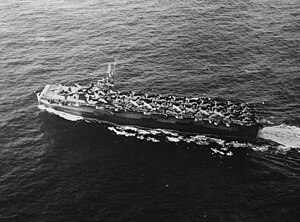 USS Fanshaw Bay (CVE-70), on a transport run, 17 January 1944
| |
| History | |
|---|---|
| Name | Fanshaw Bay |
| Namesake | Fanshaw Bay, Cape Fanshaw, Alaska |
| Ordered | as a Type S4-S2-BB3 hull, MCE hull 1107[1] |
| Awarded | 18 June 1942 |
| Builder | Kaiser Shipyards |
| Laid down | 18 May 1943 |
| Launched | 1 November 1943 |
| Commissioned | 9 December 1943 |
| Decommissioned | 14 August 1946 |
| Stricken | 1 March 1959 |
| Identification | Hull symbol: CVE-70 |
| Nickname(s) | Fannie Bee[2] |
| Honors and awards | 5 Battle stars, a Presidential Unit Citation for conduct during the Battle off Samar |
| Fate | Sold for scrap, 26 August 1959 |
| General characteristics [3] | |
| Class and type | Casablanca-class escort carrier |
| Displacement |
|
| Length | |
| Beam |
|
| Draft | 20 ft 9 in (6.32 m) (max) |
| Installed power |
|
| Propulsion | |
| Speed | 19 knots (35 km/h; 22 mph) |
| Range | 10,240 nmi (18,960 km; 11,780 mi) at 15 kn (28 km/h; 17 mph) |
| Complement |
|
| Armament |
|
| Aircraft carried | 27 – 30 (combat operations) |
| Aviation facilities | |
| Service record | |
| Part of: |
|
| Operations: | |
USS Fanshaw Bay (CVE-70) was a Casablanca-class escort carrier of the United States Navy. She was named after Fanshaw Bay, located within Cape Fanshaw, of the Alexander Archipelago in the Territory of Alaska. The cape was given its name by Charles Mitchell Thomas, who was mapping the area, in 1887. Built for service during World War II, the ship was launched in November 1943, and commissioned in December, and served in support of the Mariana and Palau Islands campaign, the Battle off Samar, and the Battle of Okinawa. Postwar, she participated in Operation Magic Carpet. She was decommissioned in August 1946, when she was mothballed in the Pacific Reserve Fleet. Ultimately, she was sold for scrapping in September 1959.